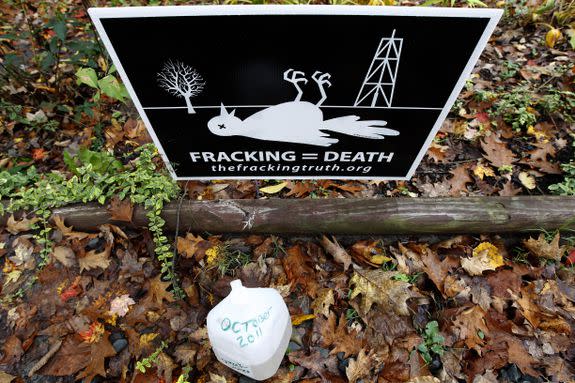Yes, it's true: Fracking is contaminating drinking water

Fracking has contaminated drinking water and strained local water supplies in some circumstances, the U.S. Environmental Protection Agency found this week in a highly anticipated report.
In the report, the EPA scrapped language from a previously released draft that said there was no evidence that fracking has had "widespread, systemic impacts" on U.S. drinking water. The draft had come under criticism by environmental groups and others opposed to fracking.
The EPA's assessment "is the most complete compilation to date of national scientific data" on the relationship between fracking and drinking water, Thomas Burke, a deputy assistant administrator and science adviser at the EPA, said Tuesday in a statement.
SEE ALSO: U.S. may be 'biggest culprit' of global spike in methane emissions, study says
The new report marks an important turning point in the U.S. debate over hydraulic fracturing, which is the formal term for the oil and gas extraction technique.
Fracking involves blasting millions of gallons of water with sand and chemicals into tight shale formations to crack open rocks and free up oil and natural gas reserves. Combined with horizontal drilling, the process has helped drive a massive surge in U.S. oil and gas production in the last decade.
% Fracking In Natural Gas

Image: Energy information administration
% Fracking In Crude Oil

Image: Energy information administration
For years, energy companies have insisted that fracking is completely safe, and that stringent safety regulations would only hinder America's efforts to create jobs and reduce its dependence on foreign oil supplies. Currently, fracking is primarily regulated at the state and local level.
Meanwhile, environmental groups and scientists have voiced concerns that people living near wells are exposed to toxic air and water pollution and face heightened cancer risks.
But U.S. regulators didn't weigh in for a long time, even as hundreds of thousands of wells were being fracked around the country. Then in 2015, at the urging of Congress, the EPA began a comprehensive study of how fracking might affect drinking water sources.

Image: AP photo/alex brandon
The EPA initially said in its June 2015 draft version that it "did not find evidence" that fracking has led to "widespread, systemic impacts on drinking water resources in the United States." In response, the EPA's independent Scientific Advisory Board insisted the agency should back up that conclusion with quantified data.
Burke, the EPA science adviser, said the agency tried to, but could not quantify that draft's conclusion. So the EPA deleted that language from its final report, he told reporters on Tuesday.
In the report, the EPA looked at five stages of the fracking process, illustrated below:

Image: U.S. environmental protection agency
The EPA said it identified impacts on drinking water in each of the five stages.
While some effects were temporary or not severe, the agency said it identified a handful of conditions under which fracking activities can have more frequent or severe impacts. They include:
Withdrawing fracking water in places with limited or declining groundwater availability.
Spilling fracking fluids, chemicals or the contaminated water that flows back to the surface (produced water), resulting in large volumes of chemicals reaching groundwater resources.
Injecting fracking fluids into poorly constructed wells, so that gases or liquids affect the groundwater.
Injecting fracking fluids directly into groundwater resources.
Sending contaminated fracking wastewater back into surface water resources.
Disposing of or storing fracking wastewater in unlined pits so that the toxic water contaminates groundwater.

Image: AP photo/alex brandon
Still, the EPA admits that its report is far from the final word on fracking's environmental safety.
Huge gaps in data and information on fracking activities hindered the agency's ability to fully assess fracking's potential impacts on drinking water, both locally and nationwide. Comprehensive data on fracking activities is either not collected, not publicly available or is prohibitively difficult to aggregate, the EPA said.
Oil industry groups argue that plenty of data does exist and proves that fracking is safe. The American Petroleum Institute, a major lobbying group, blasted the EPA this week for changing its tune in the fracking report.
"The science and data clearly demonstrate that hydraulic fracturing does not lead to widespread, systemic impacts to drinking water resources," Eric Milito, the petroleum group's upstream director, said in a statement.
Meanwhile, environmental groups said the EPA's report confirms what they've been saying all along.
Final EPA Study Confirms Fracking Contaminates Drinking Waterhttps://t.co/HLoCvupJvC
— Mark Ruffalo (@MarkRuffalo) December 13, 2016
"The Obama administration has rightly prioritized facts and science, and put public health and environmental protection over the profit-driven interests of the oil and gas industry," said Wenonah Hauter, executive director of Food & Water Watch, which is calling for a national fracking ban.
The incoming Trump administration, however, will likely take a different tack.
President-elect Donald Trump has vowed to expand fracking and scrap any Obama-era regulations pertaining to the practice.
